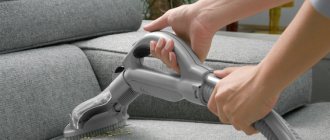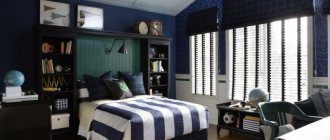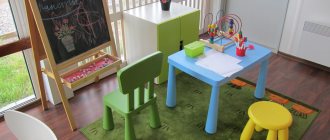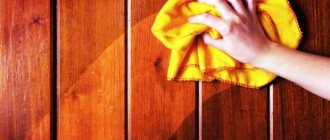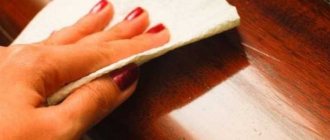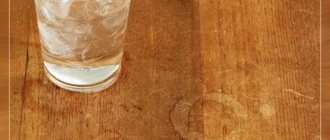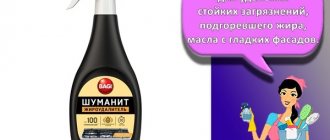The glossy surface adds chic to cabinet furniture and creates the illusion of expanding space. Glossy surfaces are especially popular with children, who cover them with their handprints and paint them with markers.
A kitchen with a glossy facade looks very aesthetically pleasing and attractive.
The unsightly picture is complemented by cooking stains, defects and unpleasant odors that arise from improper care. Everything together does not look aesthetically pleasing. Arm yourself with patience and our advice, and your glossy furniture will shine with its pristine shine.
Caring for such a headset requires a lot of effort and time.
Polyvinyl chloride film
She is afraid of everything - high temperatures and humidity, rough mechanical and chemical influences and abrasive additives.
Under no circumstances should PVC film be washed with a very damp cloth.
Also, the formation of cracks and peeling of the film can be caused by:
- Exposure to bright lighting fixtures;
- Temperatures below -15° C.
To prevent the film from peeling off the facade, try to wipe the surface with a not very damp cloth.
The surface of furniture, floors and metal objects painted with nitro-enamel paints, such as refrigerators, strollers, washing machines, wears out over time and even in the apartments of the most tidy housewives becomes dull. It appears stains, scratches and other damage.
This happens from atmospheric influences, mechanical stress, dust and dirt. Polishing products help prevent premature wear of household items, maintain matte or glossy polishing of furniture, add shine and color shades to various floor coverings, reduce the time and labor intensity of household work, and maintain cleanliness and comfort in the apartment. They are the most important group in the range of household chemicals. Polishing agents are predominantly mixtures consisting of combinations of waxes, wax-like substances and suitable solvents. Their consistency is solid and liquid.
It is significantly easier to process wood and other surfaces with polishing agents containing organosilicon liquids or silicones. Silicones do not interact with waxes, but by enveloping their crystals, they make it much easier to rub the wax on the surface and obtain a better shine. In addition, silicones are hydrophobic, i.e. they repel water and do not retain it on the surface.
After the polishing agent is applied to the surface, the solvent evaporates and a thin, more or less elastic film remains, which covers all pores, scratches, etc. This film can have a shine from the nature of the product itself or can be induced by subsequent minor mechanical polishing (wiping ).
The film formed on the surface also has protective and hygienic properties. It binds dust and at the same time bacteria present in the dust. On the floor, it envelops grains of sand, small specks, etc. with wax or wax-like substances, due to which they lose their scratching properties.
In addition to the listed advantages, the film has a number of other properties: sufficient adhesiveness to firmly adhere to the surface; a certain hardness to prevent rapid wear and tear when walking on the floor; ability to polish so that it is possible to achieve the desired gloss, etc.
The most common and deserve a lasting good reputation are polishing agents, described below.
"Gloss".
It is a colorless or slightly yellow liquid. The preparation "Gloss" cleans and gives a renewed look and shine to furniture and other varnished, polished and etched wooden products. The composition of the gloss is simple: turpentine (turpentine oil) (65%), petroleum jelly (34.8%) and ceresin (0.2%).
The method of application is very simple. A flannel cloth swab is moistened with the “Gloss” preparation and the wooden surfaces are wiped with it. After wiping, varnished and polished surfaces should have a renewed appearance and shine. "Gloss" is sold in glass bottles of 200 g
with screw-on plastic heads (plugs).
"Shine".
It is a homogeneous pasty mass from light cream to cream color, also consisting of waxes and wax-like products, organosilicon liquid and organic solvents. “Shine” paste is used to refresh polished wooden furniture.
The composition of “Blesk” is as follows: bleached montan wax (12%), refined petroleum paraffin (4%), synthetic ceresin (9%), vaseline oil (3%), gasoline solvent used in the paint and varnish industry - white spirit (54 %), turpentine (8%), terpineol (5%), polymethylsilicone or polyethylsilicone liquid (5%).
The method of use is a little more complicated than "Gloss", but it is also not difficult. A thin layer of paste is applied with flannel to the surface, cleaned of dust and dirt. After 10 minutes, rub the surface with a dry cloth or flannel until shiny.
“Shine” paste is packaged in glass jars of 100-200 g
. The lids of the jars can be plastic or metal with cardboard gaskets.
"Gamma".
It is a yellow to dark orange liquid waxy composition. The scope of application of this drug is more extensive. It can be used to care for polished furniture, parquet floors and linoleum-covered floors. The composition of "Gamma" includes many chemicals: gasoline solvent (77%), terpineol (5%), turpentine oil - turpentine (5%), synthetic high-melting ceresin (10%), bleached wax-montane (2.6% ), fat-soluble orange dye (0.1%) and essential oils, which give the preparation a pleasant smell.
The “Gamma” preparation is used as follows: first, shake it thoroughly, then soak a flannel or gauze swab with the preparation and cover the surface to be given shine with a thin and uniform layer. After approximately 15 min. the surface to be treated will dry and rub it with a woolen cloth to the desired shine.
"Gamma" is also packaged in small glass bottles of 200 g
, sealed with cork stoppers and filled with resin; bottles can be closed with screw-on plastic caps.
"Extra".
Whitish, sometimes with a yellow tint, polishing emulsion has the following feature: it not only refreshes the surface, but also removes dirt from it. "Extra" is used to care for products made of wood, plastics, vinyl chloride and other coatings.
The composition of "Extra" includes: paraffin (1%), galosh gasoline (36%), turpentine (1%), oleic acid (6%), linseed oil (3%), triethanolamine (3%), bleached wax -montane (0.5%), butyl acetate (1%), silicone liquid (2%) and water. The polishing composition is packaged in two-hundred-gram bottles with screw-on plastic heads or a cork stopper filled with resin.
There is no need to worry if the “Extra” drug you purchased, after standing for a while in your home, delaminates. This does not reduce its quality, you just need to shake it well before using it.
Before starting the cleaning and polishing procedure, remove dust from the surface being treated. Then moisten a cloth or cotton swab with water, then pour the “Extra” preparation onto it and wipe the item. You cannot wait until the drug dries. It is necessary to immediately begin to rub the still damp surface with a cloth. After a while, a shine will appear.
"ZhVS?2."
This is a yellow liquid wax composition. It is used both as a polishing agent and as a disinfectant for furniture, parquet floors, linoleum and other surfaces.
“ZhVS?2” includes the following components: “galosh” gasoline or B?70 (83%), synthetic ceresin (12%), organosilicon liquid (2%), fatty orange dye (0.01%) and a small amount of insecticidal (poison) means (about 3%). The liquid wax composition “ZhVS?2” is sold in bottles weighing 200 g
. The method of application is almost the same as the drug "Gamma". The contents of the bottle are first shaken well. A flannel swab is moistened with “ZhVS?2” and wiped with it on the wooden surfaces of furniture, parquet floors and linoleum. After 10-15 minutes. rub with dry woolen cloth or flannel until a good shine appears. The insecticides included in this drug protect household items from breeding household insects in them. The drug “ZhVS?2” has been produced by industry for several years, and precisely because it contains poisons that kill parasites, “ZhVS?2” is in great and steady demand.
In addition to the described household chemicals intended for the care of household items, the industry produces other similar preparations. In terms of composition and method of application, they are similar to one another, but due to some features they have different names, for example “Spark”, “Rainbow”, etc.
"Spark".
This is a liquid product for renewing varnished surfaces and giving them shine. Please note that previous products were mainly recommended for polished surfaces. The method of use is similar to the “Gloss” product. The contents of the bottle are shaken, a cotton swab covered with gauze or flannel soaked in the preparation is used, the varnished surfaces are wiped and then polished with a soft cloth.
"Rainbow".
"Rainbow" is a silicone liquid intended for updating polished and varnished furniture. This drug has some peculiarities in its use: after it is applied to the surface, you do not need to rub it immediately, but wait at least two hours. Only after two hours, the film formed on the surface is rubbed well with a cloth or woolen cloth until a stable shine is obtained.
The “Rainbow” preparation produces a durable, shiny film that is quite resistant to water, since this chemical assistant contains silicone.
"Polish?2."
This is a light yellow to dark yellow paste designed for cleaning and refreshing polished and varnished surfaces.
The following raw materials are used to make the paste: ceresin, beeswax, turpentine, white spirit and insecticides (poison). The paste is packaged in tin or glass jars of 100-200 g
.
The method of application is simple: apply the paste to the flannel and vigorously rub the surface, then wipe it with a dry cloth until it becomes shiny.
"Polish? AYA."
Polish is a white liquid emulsion intended for cleaning and refreshing varnished surfaces. As well as
other polishing agents, "Polish" is not complex in composition and is similar in use, especially with the preparation "Iskra". Shake the emulsion “Polish” before use. Then a small amount is applied to the flannel and wiped over the surface. After this, it is recommended to rub furniture or other varnished surfaces with cloth until shiny.
"Polish" is sold in small bottles of 50 g
and in bottles of 200
g
.
"Biychanka."
This is a silicone liquid intended for cleaning, updating and glossing furniture. The flannel is moistened with liquid and easily applied to the surface.
After drying, wipe the surface with dry flannel or cloth until shiny.
"Vici-politura".
“Vitsi-politura” is a liquid that is used both to remove dirt, dust, stains from furniture, and to add shine to polished and varnished furniture.
"Rits."
"Rits" is a liquid for cleaning and renewing lacquered furniture. The liquid contains silicone, which gives the surface a good and lasting shine.
To care for polished furniture, the chemical industry began to produce products in aerosol packaging - a metal or polyethylene canister that operates on the principle of a spray bottle.
Aerosol "Speedums".
This liquid removes dirt from polished and varnished furniture in the form of stains, dust, grease, and also adds shine to the surface.
The method of using household chemicals in aerosol packaging is very simple: remove the cap and press the spray head (valve) with your finger; The liquid should be sprayed evenly on the surface of the furniture.
Use a swab or soft cloth to remove dissolved dirt and excess liquid from a polished or varnished surface. After 5 min. the surface can be rubbed with a dry soft cloth until shiny.
When working with aerosols, the following precautions should be observed: do not spray near an open flame, do not allow the cylinders to heat above 35°, and disassemble the aerosol packaging yourself.
To care for floors, the chemical industry produces a number of special paste and emulsion mastics.
When you rub the floor with mastic, the room has a neat and elegant look. In addition, mastic protects the floor from rapid contamination. To keep floors clean and shiny, you can use mastics, described below.
Turpentine floor mastic.
Paste-like light mass or colored with fatty dyes. It is used for rubbing floors, linoleum and giving them shine and a certain color. Turpentine mastic is produced without dye and with dyes: yellow, orange and red. The composition of turpentine mastic includes: paraffin (25%), ceresin (15%), turpentine (59.7%) and fatty dyes (0.3%). This mastic gives a soft elastic film.
Turpentine-wax floor mastic.
This mastic differs from turpentine mastic in that waxes - beeswax or montane - are added to its composition.
Turpentine-wax mastic produces a harder film, but less elastic. Turpentine and turpentine-wax mastics are sold in tin and glass jars of 250-400 g
. The method of using them is the same. First, the floor is cleaned of dust and dirt. Then, with a cloth, mastic is applied to the floor in an even and thin layer. After 30-40 minutes. The mastic is rubbed with a floor polisher, floor brush or woolen cloth until shiny.
Water-soluble wax floor mastic.
Mastic is an emulsion of wax and solid hydrocarbons in an aqueous solution of emulsifiers; it has the appearance of a homogeneous and non-separating paste.
They produce uncolored mastic, yellow, orange and red. Water-based mastic is easily diluted with warm water and is easily applied to the floor.
The following raw materials are used to make mastic: mountain wax, imported montan and beeswax, paraffin, ceresin, oleic acid, soda ash, rosin and fat-soluble dyes - red, orange and yellow. The mastic is dissolved in warm water and applied with a brush to the floor. After drying, the floors should be polished until shiny. The mastic is packaged in briquettes, glass or tin jars.
Mastic "BM".
This is a white paste-like mass intended for rubbing parquet floors and linoleum. It is produced in two varieties: with and without silicone liquid. The first contains: galosh gasoline (74%), terpineol (1%), synthetic ceresin grade 90 (21%), montane wax (2%), organosilicon liquid (2%); the second contains no organosilicon liquid, but increases to 4% wax-montane.
“BM” is packaged in glass jars weighing from 500 g
up to 1
kg
. Apply “BM” to the floor, cleaned of dirt and dust, in a thin, even layer after 10-15 minutes. it is rubbed with a polisher, polishing brush or cloth rag until a good shine is obtained. Mastic "BM" when rubbing light parquet floors does not change the natural color of the parquet.
Liquid mastic on silicone.
This mastic is a solution of montana wax, ceresin, silicone and perfume in white spirit and gasoline.
Silicone mastic is a homogeneous colorless paste used for rubbing parquet floors and linoleum.
Silicone and high-melting ceresin contribute to the formation of a water-repellent film. A floor treated with this mastic is easy to rub and acquires a lasting shine.
Table of contents
Decorative plastic (DBSP)
Waterproof and resistant to mechanical stress.
Kitchens with plastic coating must be washed with gentle detergents.
But it is defenseless against the action of chemically active substances:
- Chlorine-based substances “wash out” the color from such material;
- Wax polishes turn into a sticky film that is difficult to remove;
- Alcohol-based compounds cause the gloss to become dull;
- Detergents containing acids form dirty, indelible stains and stains - so no “domestos”, “comet” and “silita”.
Glossy plastic tends to lose color brightness, so be careful when choosing detergents.
Types of glossy coatings and care features
Before you start washing facades, you need to find out what material they are made of.
Glossy coating is made from various raw materials:
- acrylic;
- plastic;
- varnish and paint;
- PVC films.
The acrylic coating is applied to the MDF surface using polyurethane glue, resulting in a rich glossy shine. Although the material is expensive, it is easy to care for and always looks elegant. It is quite easy to remove dirt from it, and any damage that occurs can be polished. At the same time, acrylic enamel is not resistant to mechanical damage and aggressive chemical components.
Unlike elite acrylic, plastic is a budget option. Kitchen cabinet fronts are made from cheaper chipboard, onto which a laminated paper sheet of plastic is glued. This is done using the postforming method: under high pressure and at high temperature.
The plastic coating is resistant to damage and any non-aggressive detergents, but if defects and scratches appear on the surface, it becomes impossible to remove them. The plastic facade has the main advantage of being 100% waterproof, so it can be washed without fear of deformation. This gloss is highly durable and has a long service life.
Low-quality glossy plastic is prone to rapid loss of color brightness, which should be taken into account when using detergents.
On painted MDF facades, the glossy effect is achieved using several layers of varnish. They can be called high-quality only if the production technology is followed, from sanding and priming the surface to thoroughly sanding and drying each layer of varnish separately.
The varnished coating is considered quite resistant to external influences
Compared to plastic, the gloss of painted facades can, if necessary, correct minor defects or make them less noticeable. The doors of the set, coated with varnish, do not need to be hidden from direct sunlight, although their color may change slightly if exposed to the sun for a long time. This gloss is not afraid of moisture and temperature changes, so it does not deform upon contact with liquid .
If the varnished gloss is mechanically damaged, there is a high probability of paint chipping.
Glossy PVC film is applied exclusively to MDF facades using the hot vacuum pressing method. Along with kitchens with plastic facades, such products belong to budget category furniture. The surface of the film is resistant to discoloration and abrasion, but it is better not to expose it to direct sunlight.
wash PVC gloss with household detergents that do not contain abrasive components.
If you are not sure of the quality of workmanship, you should not use a wet sponge for cleaning. If moisture constantly gets on a poorly pressed surface, the film will begin to peel off after some time.
Acrylic plastic
It tolerates wet cleaning well and can be treated with polish. It does not fade in the sun, does not fade and is resistant to mechanical stress.
Contaminants from such a surface can be removed quite easily. These facades can be polished when defects appear on them.
However, it is also sensitive to the chemical composition of cleaning products.
Under no circumstances should you wash them with aggressive detergents, as you may lose the shine of the glossy façade.
The main causes of contamination in glossy kitchens
Dirt and stains on a glossy surface are especially visible.
In a room where food is constantly being prepared, factors are added that increase the formation of dirty marks on furniture surfaces:
- elevated temperature;
- humidity;
- fumes from food being cooked on the stove;
- touching fingers;
- accidental contact of products on the surface and walls of furniture.
This leads to the appearance of individual spots and a uniform greasy film on the shiny surface.
If you do not wash a glossy kitchen from dirt in time, under their influence the shine will disappear and the coating will become dull. A network of small cracks forms on it.
It is difficult to clean damaged smooth furniture, and it is often impossible to restore it to its original appearance.
Painted MDF with varnish
A high-quality multi-layer varnish coating applied over enamel paint does not peel off, does not allow moisture to pass through, and does not fade from bright daylight.
Small defects during use on a painted surface can be corrected, unlike plastic.
The scratched surface can be easily restored. Does not tolerate melamine sponge and high temperatures.
But you still need to try as much as possible to avoid scratches.
Selection of household chemicals for glossy facades
The delicacy of the varnish surface requires not only careful selection of tools, but also the refusal to use a number of common detergents. Some of them, despite their effectiveness in combating dirt, are completely unsuitable for cleaning gloss.
Prohibited drugs
The full list is quite extensive. But we can identify the main categories, the use of which should be abandoned when washing shiny facades:
- Any powder detergents - Pemolux, Comet and the like. They will definitely scratch the smooth shiny layer.
- Acid-containing gels and liquids intended for cleaning plumbing fixtures and ceramic products. Their use will inevitably lead to clouding of paint and even plastic facades.
- Technical solvents - acetone, white spirit, gasoline and ammonia compounds. They can not only damage the glossy finish, but also discolor it.
- Cleaning products for kitchen appliances - electric and gas stoves, hobs, microwave ovens.
Although aggressive preparations are considered effective, completely avoiding them will preserve the shine of a glossy kitchen.
Suitable means
Window and mirror cleaners are suitable for glossy surfaces
Despite the strict conditions when choosing detergent compositions, you can find a variety of cleaners suitable for shiny surfaces in stores.
- Specialized means . They must have an indication on the packaging - “for glossy coatings”.
- Washing liquids for dishes . Before applying to the contaminated area, they must be mixed with warm water. It is better to wipe with a sponge wrung out until damp.
- Cleaning products for windows, mirrors and glass surfaces . But before purchasing, you need to make sure that they do not contain any acids.
- Polishes for adding shine and applying a protective film to a glossy façade. They are also used to remove minor scratches on paint and acrylic coatings.
The form of the chosen product is important. Using gels instead of liquid preparations will allow you to avoid the risk of over-wetting the glossy coating. Sprays make it possible to apply the right amount of liquid and easily wash it off after cleaning.
So that the furniture shines with cleanliness, and you with delight
To carefully and effectively clean your kitchen unit from grease and dirt, use regular laundry soap. Grate it on a fine grater and dilute it in warm water until a soap solution forms.
Laundry soap diluted in water will help to wash the plastic surface without unnecessary damage.
Clean in three steps:
- First apply the solution to it;
- Then wipe first with a wrung out damp cloth and then with a dry cloth;
- Be sure to ventilate the room.
Soap solution is the most harmless for glossy finishes of kitchen units, but does not always give a good result.
To effectively clean facades, many housewives quite successfully use:
- Glass cleaners (without ammonia);
- Special sprays for glossy finishes;
- Detergents for shower cabins;
- Shampoos and liquid soap;
- Dishwashing detergents;
- Wax-free polishes;
- Hydrogen peroxide.
To wash surfaces with a glossy facade, use non-abrasive detergents.
If you find a fresh greasy stain or dirty streaks on the facade, try wiping them off with light pressure with a flannel cloth moistened with glass cleaner.
For painted glossy facades it is good to use glass cleaner.
IMPORTANT! Carry out such cleaning as often as possible - and you won’t have to make heroic efforts to remove old defects.
It is recommended to apply the product to the facades and wipe with a dry microfiber cloth.
The glossy facade will retain its radiant shine for a long time if you handle it with care.
Select cleaning products carefully and use wipes made of soft and non-woven materials.
Problem No. 3. Scratches appeared
If the scratch is small, try the good old remedy - sunflower oil. Try soaking a cotton pad in it and wiping the surfaces.
If the chip is of “moderate severity” but does not reach the wood, you can use:
- Wax polish. Rub it thoroughly over the damaged area until it becomes smooth.
- Special spray varnish for door repair (halo-free, based on one-component acrylic). It can be purchased from door manufacturers or sellers - you are unlikely to find it in a regular repair store. The rules for its use are described on the label of the can.
In case of serious damage to varnished veneer, there is also a good solution:
- Pick up a hard wax pencil that matches the color of your facades at a hardware store (in the door or laminate department).
- Melt the pencil (or simply knead the wax with your fingers) and rub the dent until the wax completely fills it.
- Wait until the wax hardens, and then carefully remove any excess wax with a spatula or blade (not a rag!).
- Sand the area using a sander or 400-grit sandpaper.
- Cover the surface with a non-halo repair varnish (the usual one will not work, it will crumble quickly).
These instructions are also suitable for film facades. The most difficult thing is to choose the right color. If the film imitates wood, then you can use a set of markers for laminate flooring. In this case, there is a 100% chance of hitting the color.
Tip: before going to the “heavy artillery” and rubbing the varnish with various polishes and waxes, try to carefully cover the chip using a thin artist’s brush and matte varnish. Perhaps the result at this stage will satisfy you.
If the scratch is so deep that the wood is touched, then before applying wax we clean the edge, mix the stain with alcohol or solvent and tint the damaged area. Then do steps 1–4 above.
If the facades of your set are made of glossy plastic, then it is almost impossible to correct its flaws. Most likely, the plastic will have to be re-glued.
Glossy furniture in the kitchen interior – 50 photo ideas:
Matte kitchen
Many apartment dwellers prefer to decorate their kitchens in matte colors. This design method is most often chosen by those who value comfort and family warmth. The muted shade of furniture facades enhances the feeling of comfort, especially in the winter cold. Matte finish is the only possible option for decorating rooms in the styles of Provence, country, shabby chic, etc.
What to avoid when caring for glossy surfaces
When choosing care products for glossy furniture, you should remember that aggressive chemical and abrasive components can permanently ruin shiny surfaces.
Before purchasing a furniture care spray or liquid, you must make sure that the product does not contain:
- chemical aggressive elements;
- solvents and alcohol;
- turpentine;
- synthetic resins;
- ammonia;
- chlorine and acetone.
Dry sponges, hard brushes, and melamine sponges are strictly prohibited for cleaning glossy surfaces. Do not wipe glossy furniture with aggressive chemicals for microwave ovens, bathtubs or stoves.
Related article: Black kitchen: 5 design tips
Attention: before using a new cleaning product, it must first be tested on an inconspicuous area of the glossy furniture facade.

